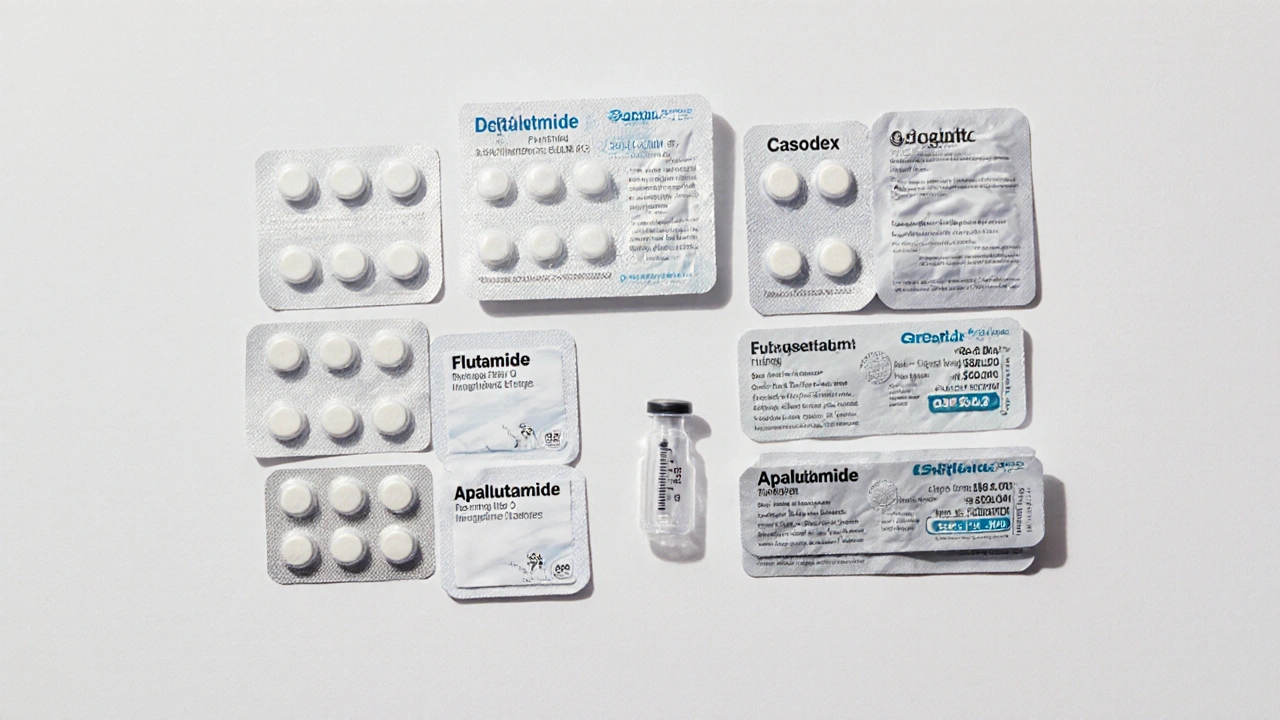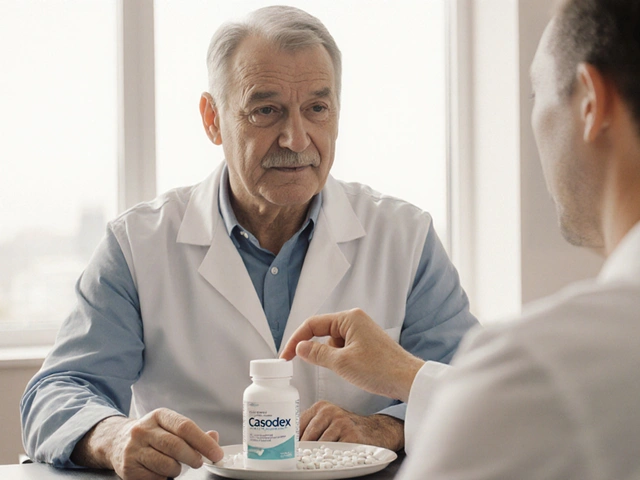Casodex vs Other Prostate Cancer Antiandrogens
Mechanism: Non-steroidal AR antagonist
Form: Oral tablet
Dosage: 50 mg daily
Price (2025): ~$2,800/year
Side Effects: Mild liver enzyme elevation, hot flashes
Mechanism: Second-gen AR antagonist with nuclear translocation block
Form: Oral tablet
Dosage: 160 mg daily
Price (2025): ~$95,000/year
Side Effects: Fatigue, hypertension, rare seizures
Mechanism: AR antagonist with reduced CNS penetration
Form: Oral tablet
Dosage: 240 mg daily
Price (2025): ~$92,000/year
Side Effects: Rash, fatigue, hypertension
Mechanism: GnRH antagonist
Form: Subcutaneous injection
Dosage: 240 mg monthly
Price (2025): ~$26,000/year
Side Effects: Injection site reactions, hot flashes
| Attribute | Casodex | Enzalutamide | Apalutamide | Degarelix |
|---|---|---|---|---|
| Mechanism | AR antagonist | AR antagonist + translocation block | AR antagonist | GnRH antagonist |
| Administration | Oral daily | Oral daily | Oral daily | Injectable monthly |
| Cost (Annual) | $2,800 | $95,000 | $92,000 | $26,000 |
| Side Effects | Mild liver enzymes, hot flashes | Fatigue, hypertension, rare seizures | Rash, fatigue, hypertension | Injection site reactions, hot flashes |
| Best For | Hormone-sensitive disease with cost concerns | Metastatic CRPC or high-risk nmCRPC | nmCRPC with high PSA doubling time | Rapid suppression, oral intolerance |
Treatment Recommendation
When facing hormone‑sensitive prostate cancer, the choice of antiandrogen can feel overwhelming. Casodex is a brand name for bicalutamide, an oral non‑steroidal antiandrogen that blocks the androgen receptor. It’s been on the market for over two decades, but newer agents such as enzalutamide or apalutamide promise higher potency, while injectable options like degarelix avoid daily pills altogether. This guide walks you through the most important factors-efficacy, side‑effect profile, dosing convenience, and cost-so you can see where Casodex fits in the current treatment landscape.
Quick Takeaways
- Casodex is affordable and oral, making it a solid first‑line option for many men on androgen‑deprivation therapy (ADT).
- Newer oral antiandrogens (enzalutamide, apalutamide, darolutamide) show stronger tumor control but cost 3-5× more.
- Injectable degarelix works faster and avoids the flare phenomenon but requires monthly clinic visits.
- Side‑effect severity varies: Casodex often causes mild liver enzyme elevation, while enzalutamide can trigger seizures in susceptible patients.
- Choosing the right drug hinges on disease stage, comorbidities, insurance coverage, and personal preference for pill versus injection.
How Casodex Works
Casodex belongs to the class of non‑steroidal antiandrogens. It binds to the androgen receptor (AR) in prostate cells, blocking testosterone and dihydrotestosterone (DHT) from activating the receptor. Unlike surgical castration or luteinizing‑hormone‑releasing hormone (LHRH) agonists, Casodex does not reduce circulating testosterone; instead, it prevents the hormone from driving tumor growth. Because it’s taken orally once daily, adherence is generally high, and it can be combined with LHRH agonists (e.g., leuprolide) for maximal androgen suppression.
Key Comparison Criteria
When evaluating Casodex against alternatives, consider these five pillars:
- Mechanistic potency: How strongly does the drug block AR signaling?
- Clinical efficacy: Progression‑free survival (PFS) and overall survival (OS) data from pivotal trials.
- Side‑effect profile: Frequency of hepatotoxicity, hot flashes, hypertension, seizures, etc.
- Administration & convenience: Oral daily pill versus monthly injection, need for clinic monitoring.
- Cost & insurance coverage: Average wholesale price (AWP) in the U.S. and typical out‑of‑pocket expenses.

Alternative Antiandrogens Overview
Below is a quick snapshot of the most common alternatives. Each entry includes a first‑time microdata definition.
Flutamide is an older oral non‑steroidal antiandrogen that predates bicalutamide. It requires three tablets daily and has a higher incidence of liver toxicity.
Enzalutamide is a second‑generation AR antagonist that blocks receptor translocation and DNA binding. FDA‑approved in 2012 for metastatic castration‑resistant prostate cancer (mCRPC) and later for non‑metastatic disease.
Apalutamide shares a similar mechanism to enzalutamide but was designed to reduce central nervous system penetration, lowering seizure risk. Approved for non‑metastatic castration‑resistant prostate cancer (nmCRPC) in 2018.
Darolutamide is a novel AR antagonist with a distinct chemical backbone that minimizes blood‑brain barrier crossing. FDA‑approved in 2019 for nmCRPC.
Degarelix is a peptide‑based GnRH antagonist given as a subcutaneous injection every month. It achieves rapid testosterone suppression without the initial flare seen with LHRH agonists.
Leuprolide is an LHRH agonist that lowers testosterone after an initial surge. It’s often paired with antiandrogens like Casodex to block that surge.
Abiraterone inhibits CYP17A1, blocking androgen synthesis in the testes, adrenal glands, and tumor itself. Usually combined with prednisone to mitigate mineralocorticoid excess.
Prostate Cancer is the second most common cancer in men worldwide, driven in many cases by androgen receptor signaling.
Side‑by‑Side Comparison Table
| Attribute | Casodex (Bicalutamide) | Flutamide | Enzalutamide | Apalutamide | Darolutamide | Degarelix (Injectable) |
|---|---|---|---|---|---|---|
| Mechanism | AR antagonist (oral) | AR antagonist (oral) | AR antagonist + nuclear translocation block (oral) | AR antagonist (oral) | AR antagonist (oral) | GnRH antagonist (injectable) |
| FDA Approval Year | 1995 | 1993 | 2012 (mCRPC), 2018 (nmCRPC) | 2018 | 2019 | 2008 |
| Typical Dose | 50mg PO daily | 250mg PO TID | 160mg PO daily | 240mg PO daily | 600mg PO daily | 240mg SC monthly |
| Average Wholesale Price (US, 2025) |
$2,800 / year | $3,200 / year | $95,000 / year | $92,000 / year | $98,000 / year | $26,000 / year |
| Key Side Effects | Elevated liver enzymes, hot flashes, GI upset | Liver toxicity (more frequent), GI upset | Fatigue, hypertension, seizures (rare) | Rash, fatigue, hypertension | Fatigue, GI upset, low seizure risk | Injection site reactions, hot flashes |
| Best Clinical Use | Combined with LHRH agonist for hormone‑sensitive disease | Historical alternative when casodex unavailable | mCRPC or high‑risk nmCRPC | nmCRPC with high PSA doubling time | nmCRPC patients at seizure risk | Patients needing rapid testosterone suppression or avoiding oral meds |
Who Should Choose Casodex?
Casodex shines in scenarios where cost, convenience, and a well‑established safety record matter most. Consider it if you:
- Are newly starting ADT and need a reliable oral partner for leuprolide or another LHRH agonist.
- Have mild liver function abnormalities-bicalutamide’s hepatic impact is usually low‑grade and reversible.
- Prefer a once‑daily pill over monthly clinic visits.
- Have insurance that covers generic bicalutamide but places higher hurdles on newer agents.
If you belong to any of the above groups, the benefit‑to‑cost ratio of Casodex often outweighs the modest efficacy boost seen with second‑generation drugs.

When Might an Alternative Be a Better Fit?
Newer antiandrogens become attractive when disease is more aggressive or when you have specific comorbidities:
- High‑risk nmCRPC: Enzalutamide or apalutamide have demonstrated >30% improvement in metastasis‑free survival compared with placebo.
- Seizure history: Darolutamide’s limited CNS penetration makes it safer.
- Need for rapid testosterone drop: Degarelix reaches castrate levels within 48hours, avoiding the flare of LHRH agonists.
- Intolerance to oral meds: Patients with severe dysphagia or chronic nausea may favor an injectable like degarelix.
Practical Tips & Common Pitfalls
- Monitor liver enzymes: Check ALT/AST at baseline, then every 2-3 months while on Casodex or flutamide.
- Avoid abrupt discontinuation: Sudden stop can cause rebound testosterone spikes; taper when switching agents.
- Combine with ADT wisely: Casodex alone is insufficient for castration‑sensitive disease; it should accompany an LHRH agonist or antagonist.
- Watch for drug‑drug interactions: Bicalutamide can increase serum concentrations of warfarin and certain statins.
- Insurance navigation: Submit prior‑authorization requests with trial data (e.g., SPARTAN or PROSPER) when requesting newer agents.
Frequently Asked Questions
Can I take Casodex without any other hormone therapy?
No. Casodex is designed to be used with an LHRH agonist or antagonist to achieve full androgen suppression. Taking it alone leaves testosterone levels unchanged.
How does the side‑effect profile of Casodex compare to enzalutamide?
Casodex mainly causes mild liver enzyme elevation and hot flashes. Enzalutamide adds fatigue, hypertension, and a small (<0.5%) risk of seizures. If you have a history of seizures, Casodex may be safer.
Is there any advantage to starting with degorelix instead of Casodex?
Degarelix provides a rapid drop in testosterone (within 48hours) and avoids the flare seen with LHRH agonists. It’s useful for patients at high risk of disease flare or those who cannot swallow pills. The trade‑off is higher cost and monthly injections.
What should I know about the cost difference between Casodex and newer antiandrogens?
In 2025, a year’s supply of Casodex runs around $2,800, while enzalutamide or apalutamide can exceed $90,000. Insurance coverage varies; many plans require step therapy, meaning you must try a cheaper option (like Casodex) before approving newer drugs.
Can I switch from Casodex to another antiandrogen without a washout period?
Typically, a short overlap of 1-2 weeks is advised to maintain androgen blockade while monitoring for side effects. Your oncologist will adjust dosing based on blood work and symptom control.
Choosing the right antiandrogen isn’t a one‑size‑fits‑all decision. By weighing efficacy, safety, convenience, and cost, you can match a therapy to your personal health goals and life circumstances. Whether you stay with Casodex or move to a newer agent, close communication with your care team ensures the best possible outcome.








Matthew Platts
October 9, 2025 AT 19:31Finding a solid, affordable antiandrogen like Casodex is a real win for anyone watching their wallet while fighting prostate cancer.
Matthew Bates
October 10, 2025 AT 15:40While the cost differential is striking, it is essential to acknowledge that the pharmacokinetic profile of bicalutamide differs markedly from second‑generation agents, and comparative efficacy data should be interpreted within the context of randomized controlled trials.
Kasey Mynatt
October 11, 2025 AT 19:26Casodex has stood the test of time, and its long‑standing safety record offers reassurance to patients and clinicians alike.
Its once‑daily oral administration eliminates the need for frequent clinic visits, which can be a significant quality‑of‑life factor.
For men who are already grappling with the emotional burden of a cancer diagnosis, the simplicity of a single pill reduces daily decision fatigue.
The drug’s mechanism of blocking the androgen receptor without reducing circulating testosterone makes it a logical partner for luteinizing‑hormone‑releasing hormone (LHRH) agonists.
Clinical studies have shown that, when combined with an LHRH agonist, bicalutamide achieves comparable control of disease progression in hormone‑sensitive settings.
Moreover, the incidence of severe liver toxicity is low, and routine monitoring of transaminases usually suffices to catch any elevation early.
Patients often report fewer central nervous system side effects compared to enzalutamide or apalutamide, which can translate into better adherence.
Cost considerations cannot be overstated; a yearly expense of roughly $2,800 is dramatically less than the six‑figure price tags of newer agents.
Insurance providers are more likely to approve generic bicalutamide, minimizing out‑of‑pocket costs for many families.
From a pharmacoeconomic perspective, the cost‑effectiveness ratio heavily favors Casodex in early‑stage disease.
Physicians should still evaluate each individual’s comorbidities, as hepatic function, cardiovascular risk, and potential drug interactions may sway the choice.
When drug–drug interactions are a concern, bicalutamide’s relatively modest impact on cytochrome enzymes simplifies polypharmacy management.
In settings where rapid testosterone suppression is not critical, the slower onset of castration levels with LHRH agents paired with Casodex is clinically acceptable.
For patients preferring an oral regimen over monthly injections, Casodex provides a convenient, discreet option.
Overall, Casodex remains a cornerstone of androgen deprivation therapy for men seeking an effective yet affordable treatment pathway.
Edwin Pennock
October 12, 2025 AT 09:20Sure, the price looks good, but you can’t ignore that its anti‑androgen potency is notably weaker than the newer drugs, and some patients end up needing a switch later, which defeats the whole “affordable” argument.
John McGuire
October 12, 2025 AT 23:13Wow, the side‑effect profile of Casodex is actually pretty chill compared to the fatigue and hypertension you see with enzalutamide! 🙌💊 It’s a solid go‑to if you want something easy on the wallet and the body.
newsscribbles kunle
October 13, 2025 AT 14:30While we celebrate cost savings, let’s remember that supporting local generic manufacturers helps our national healthcare system stay robust, unlike those pricey foreign‑made brand drugs that drain our resources.
Bernard Williams
October 14, 2025 AT 03:00For anyone weighing options, it’s useful to chart out the key differences: Casodex offers oral convenience and low cost, enzalutamide delivers higher potency but at a steep price, apalutamide sits in between, and degarelix provides rapid testosterone knockdown via monthly injection.
Michelle Morrison
October 14, 2025 AT 16:53What the pharma giants don’t tell you is that the “higher potency” claims are often inflated to justify their astronomical pricing, which keeps patients dependent on ever‑more expensive treatments.
harold dixon
October 15, 2025 AT 06:46I appreciate the thorough breakdown; it really helps patients and caregivers make an informed decision without feeling overwhelmed by medical jargon.
Darrin Taylor
October 15, 2025 AT 20:40Honestly, I think the whole focus on antiandrogen ranking is a distraction; patients would benefit more from lifestyle interventions and early screening than from debating the subtle differences between pills.
NANDKUMAR Kamble
October 16, 2025 AT 10:33Cost matters more than efficacy for many.
Ben Hooper
October 17, 2025 AT 00:26Casodex is cheap but less powerful than newer drugs it works well enough for many patients
Marjory Beatriz Barbosa Honório
October 17, 2025 AT 14:20Let’s keep the conversation supportive-everyone’s situation is unique, and sharing experiences can empower others to feel confident about their treatment path.
G.Pritiranjan Das
October 18, 2025 AT 04:13Casodex offers a reliable, budget‑friendly option that many patients successfully use.
Karen Wolsey
October 18, 2025 AT 18:06Oh sure, because paying $95,000 a year for a pill automatically makes it “better” – guess we all have unlimited credit cards now.
Trinity 13
October 19, 2025 AT 08:00When we contemplate the very nature of therapeutic choice, we are, in essence, navigating a labyrinth of values, economics, and the fragile human desire for control over our own mortality.
The antiandrogen spectrum, from humble bicalutamide to the towering enzalutamide, mirrors the socioeconomic stratification that permeates modern medicine.
One could argue that the true measure of a drug’s worth lies not solely in progression‑free survival statistics, but in the quiet moments when a patient can sit at the kitchen table without the crushing weight of financial anxiety.
Thus, the affordability of Casodex becomes a philosophical statement: it asserts that health should not be a privilege reserved for the affluent.
Yet, the relentless pursuit of marginally higher efficacy by pharmaceutical innovators raises the question of whether we are chasing incremental gains at the expense of accessibility.
In this tension, the clinician becomes a mediator, balancing the measurable benefits of a high‑cost agent against the intangible solace offered by a low‑cost, well‑tolerated alternative.
Every prescription, then, is a micro‑ethical decision, reflecting the larger societal contract between science, commerce, and the collective well‑being.
We must, therefore, remain vigilant, ensuring that the drive for innovation does not eclipse the moral imperative to provide equitable care.
Ultimately, the choice of antiandrogen is a personal narrative woven from threads of clinical evidence, financial reality, and individual values.
Rhiane Heslop
October 19, 2025 AT 21:53Truth is that the market forces dictate drug prices not the actual therapeutic superiority of the molecule
Dhakad rahul
October 20, 2025 AT 11:46Our nation’s strength is shown when we support home‑grown generic manufacturers, offering life‑saving treatments like Casodex without the foreign corporate greed that tries to poison our healthcare with sky‑high prices.
William Dizon
October 21, 2025 AT 01:40If you’re still unsure, talk with your oncologist about baseline liver function tests and how Casodex can be safely combined with LHRH therapy for a well‑rounded treatment plan.
Ira Bliss
October 21, 2025 AT 15:33Remember, you’re not alone in this journey-share your experiences, ask for support, and let’s lift each other up! 🌟💬